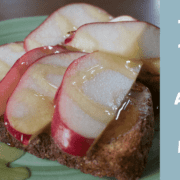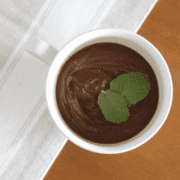Tahini toast with apples and honey is a great breakfast for a low iodine or dairy free diet. The combination of sweet and savory is delicious while the protein from tahini and fiber from the whole grain bread and apples will keep you full for hours.
Importance of Breakfast
We have all heard the saying, “Breakfast is the most important meal of the day.” Is that true?
The word breakfast comes from “breaking the fast”. No matter when you first eat for the day, you are breaking your overnight fast. That could be when you first wake up or at 2 pm. We just traditionally think of eating breakfast in the morning.
There are some benefits of eating a morning meal. Most of these have been seen through observational studies, so are not proof, but do suggest the following.
- More alertness. Our brain needs energy to function. Eating can help wake up our brain and help us feel more alert and happy. However, overeating can lead to grogginess and mental fog. With a full tank, you can also focus on your work rather than your growling stomach.
- Improved insulin sensitivity. Our bodies are more insulin sensitive in the morning, meaning it can digest the carbohydrates you consume better. Also, people who eat breakfast seem to have a lower incidence of diabetes.
- More energy. Just like your brain, your body needs energy. Fueling your body with healthy breakfast can help you get moving.
I am not saying that everyone has to eat breakfast. But I would encourage you to consider why you do not eat breakfast. Is it due to time? Do you not like traditional breakfast foods? Do you feel sick when you do? Looking at the reason may determine if there are ways you could add a healthy breakfast to your diet.
Components of a Healthy Breakfast
Any old breakfast, however, will not necessarily give you all of these benefits. You want to have a balanced meal, with good lean protein and a good source of fiber.
Why protein? Protein is essential for building and maintaining muscle. Breakfast tends to be a low protein meal for most Americans. However, if we increase our protein at breakfast and therefore distribute our intake more evenly throughout the day, we seem to retain muscle better as we age.
Another benefit of protein is it helps us feel full longer. Protein naturally takes longer for our body to digest, meaning it stays in our digestive system longer and giving us the feeling of being full.
What are good sources of protein for breakfast? Eggs, egg whites, milk, yogurt, cheese, and nut butters are common sources of breakfast protein. But you can be creative, adding beans, chicken breast, or lean beef or pork. Just avoid high sodium traditional breakfast meats too regularly, such as bacon or sausage.
Why fiber? Fiber is important for digestive and heart health. Our body cannot actually digest fiber plus fiber absorbs water and expands in our stomachs. These two combined help us feel full longer when eating high fiber foods.
Good spruces of fiber at breakfast are fruits, vegetables, and whole grains. Fruit juices are not good sources of fiber, so I would suggest whole fruit over juice.
Low Iodine Breakfast
Getting protein on a low iodine diet at breakfast can be tricky. Most of the traditional breakfast protein foods are eliminated. Egg whites and nut butters are good choices still. You could also add lean meat, just being cautious to stay within the recommended 6 ounces per day.
Fiber is easy on the low iodine diet. However, oatmeal can get monotonous quickly. You can mix up the fruits you mix in, but it will still get repetitive.
Different toast combinations are a great way to add variety as well as fruits and vegetables to your morning routine anytime, but especially on the low iodine diet. Avocado toast is particularly famous in recent years. But there are plenty of options beyond avocado.
Tahini Toast
In today’s recipe, I suggest using tahini as a spread. Not only because the taste is great, but for some variety as nut butters are consumed frequently on the low iodine diet.
Tahini is a paste made from sesame seeds, similar to peanut butter coming from peanuts. It is frequently used in Mediterranean cooking, such as recipes for hummus. It is the consistency of creamy peanut butter, but does have the oil separation seen in natural nut and seed butters. Another great plus of tahini is most brands I have ever found are unsalted, so safe for the low iodine diet.
You could switch around the toppings on your tahini toast as you prefer. Bananas and pears come to mind as good fruit substitutes. You could continue a more Mediterranean theme with tomatoes, cucumbers, and unsalted garbanzo beans.
Allergen warning: While people with peanut allergies are often also allergic to sesame seeds, tahini and other sesame seed products are usually safe for those with tree nut allergies. Please proceed with caution and discuss it with your physician/allergist.
Tahini Toast with Apples and Honey
Ingredients
- 1 slice whole grain bread homemade
- 1 1/2 tbsp tahini
- 1/2 apple, sliced
- 1 tsp honey
Instructions
- Toast bread to desired doneness.
- Spread tahini in even layer over all of bread. Lay sliced apples over the top.
- Drizzle with honey. Enjoy!



